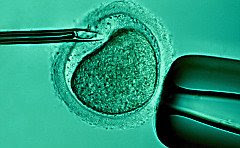FDA Approves First Human Embryonic Stem Cell Study

Friday, January 23rd 2009
Federal regulators have cleared the way for the first human trials of human embryonic stem-cell research, authorizing researchers to test whether the cells are safe to use in spinal injury patients, the company behind the trials announced Friday.
The tests could begin by summer, said Dr. Thomas Okarma, president and CEO of the Geron Corporation.
The Food and Drug Administration has approved the trials, which will use human stem cells authorized for research by former President George Bush in 2001.
The patients will be those with the most severe spinal cord injuries, called complete spinal cord injuries. ''A complete spinal cord injury has no hope of recovery below the injury,'' Okarma told CNN.
''This is significant because it's the first clinical trial of a human embryonic-based product.''
The primary purpose of the trial will be to see whether injecting these cells into a patient is safe -- but Okarma said researchers will also look for any signs of recovery.
Scientists will monitor the patients for a year following the injections for signs that they are regaining any function below the injured point.
''If there is any movement below the injury, they will measure that and record it,'' he said.
Embryonic stem cells are blank cells found in four- to five-day-old embryos, which have the ability to turn into any cell in the body.
However, when stem cells are removed, the embryo is destroyed -- which has made this one of the most controversial medical research fields in the past decade.
Federal research funds were not allowed to be used for embryonic stem-cell research until August 2001, when Bush approved spending for research using only already-existing cell lines.
Scientists later discovered that fewer than two dozen of those lines were useful for research, but abortion opponents opposed any legislation that would lift Bush's restrictions, and Bush twice vetoed congressional efforts to roll back his rules.
Stem cells are cells found in most, if not all, multi-cellular organisms. They are characterized by the ability to renew themselves through mitotic cell division and differentiating into a diverse range of specialized cell types. Research in the stem cell field grew out of findings by Canadian scientists Ernest A. McCulloch and James E. Till in the 1960s.[1][2] The two broad types of mammalian stem cells are: embryonic stem cells that are isolated from the inner cell mass of blastocysts, and adult stem cells that are found in adult tissues. In a developing embryo, stem cells can differentiate into all of the specialized embryonic tissues. In adult organisms, stem cells and progenitor cells act as a repair system for the body, replenishing specialized cells, but also maintain the normal turnover of regenerative organs, such as blood, skin or intestinal tissues.
Stem cells can now be grown and transformed into specialized cells with characteristics consistent with cells of various tissues such as muscles or nerves through cell culture. Highly plastic adult stem cells from a variety of sources, including umbilical cord blood and bone marrow, are routinely used in medical therapies. Embryonic cell lines and autologous embryonic stem cells generated through therapeutic cloning have also been proposed as promising candidates for future therapies. [3]


Comments